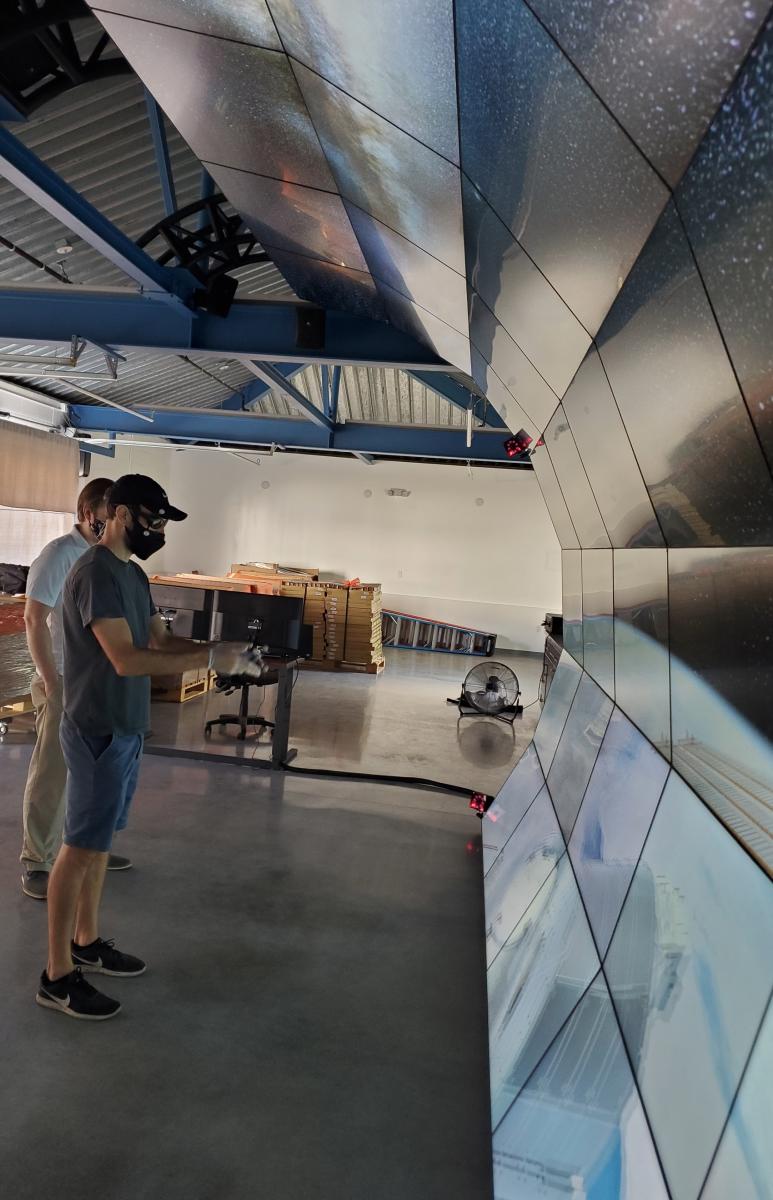VizLab: A game-changer for theoretical astrophysics:

A New Look at Our Galactic Home
Lauren Anderson, Carnegie Postdoctoral Fellow:
Our Milky Way is full of dust, which settles into the nooks and crannies of its architecture. The density of this dust coating on the galaxy’s signature spiral arms is helping Lauren Anderson visualize them in unprecedented detail. She is making a 3D dust map of the Milky Way, using data from the European Space Agency’s Gaia mission. Hopefully by early next year, she will be able to project her map onto the VizLab’s cresting wave of screens and probe the galaxy’s structure across multiple scales. “Currently, my work requires me to interpolate what’s happening between the layers of a series of 2D slices of an object,” she says. “The VizLab will allow me to look at many things simultaneously.” She hopes that the snazzy new tool will attract public attention, too. “Part of our job is to get people excited about astronomy, so the outreach potential is tremendous.”
__________

Watching a Galaxy’s Life Story
Andrew Benson, Carnegie Staff Scientist:
Andrew Benson wants to understand the role that dark matter plays in the formation and evolution of galaxies. To test different potential scenarios, he uses “really, really big calculations. But our output is an extraordinarily long list of numbers,” he explains. Right now, if he wants to interrogate a simulation, he can look at just one piece of the physics at a time, to the exclusion of everything else. With the VizLab, he will be able to move things around and interact with multiple aspects of the simulation in real time, organically revealing different properties. “The human brain is really good at finding patterns and then noticing the things that don’t fit them,” he says. “Sometimes you don’t know what to look for, but being able to visualize and play with the data can help you find things that look interesting or weird and you never know what breakthroughs could result.”
__________

Seeing the Invisible
Fangzhou Jiang, Joint Carnegie-Caltech Postdoctoral Fellow:
"Galaxies are enveloped by invisible halos of dark matter that extend far beyond the boundaries of each structure’s visible material. Fangzhou Jiang wants to use the VizLab to watch how these halos evolve, interact with inhabitant galaxies, and merge with other halos. “The universe is hierarchical,” he explains. Smaller objects formed first, accreting into larger bodies, becoming gravitationally bound to them. “By understanding their numbers and distribution, I can test the parameters of some of the universe’s fundamental physics,” he says. Jiang adds that,” having immediate access to visualizations of this caliber will allow me to better communicate the ideas underpinning my work with colleagues.”
__________
 Who: Mechdyne’s Audio Visual and Virtual Reality Solutions business unit designed, engineered, and integrated the full immersive visualization solution
Who: Mechdyne’s Audio Visual and Virtual Reality Solutions business unit designed, engineered, and integrated the full immersive visualization solution
Where: Carnegie Theoretical Astrophysics Center at the Carnegie Observatories in Pasadena, California.
What: 12-ft. high x 17-ft wide interactive virtual reality wall shaped like a cresting wave. The half-pipe design curves above viewers to a total of 162 degrees. The display allows looking up into the virtual night sky.
Why: 21st century data require 21st century laboratories -- the VizLab enables teams to better collaborate as they analyze an unprecedented amount of data.
Resolution: 72.5 million pixels
Display Size: 140-in. high, 125-in. deep, 202-In. wide
Composition: 35 specialized LCD panels capable of 2D and stereoscopic 3D display
Motion Tracking:Four optical motion tracking cameras that will track the movements of navigation wand; updating the on-screen view in real-time for a truly immersive and interactive experience
Software: Mechdyne’s getReal3D for Unity to enable data to display on a computing cluster and with user motion tracking
Audio: 5.1 channel system
Interface: Custom programmed, 10-in. touch screen control system
3D Glasses: 24 movie-style, polarized stereoscopic glasses
About this Custom Immersive Solution:
Mechdyne designed this unique configuration leveraging display technology that enables delivery of highly detailed images in a custom angled format. It is the first time that a stereoscopic display has been designed with this configuration. Mechdyne designed and built the custom structure for the panels, specified and integrated the graphics computing system, and provided software that will enable Carnegie teams to experience their astrophysical and cosmological data in extreme detail with greater insight into spatial relationships thanks to stereoscopic 3D viewing.
About Mechdyne:
Based in Marshalltown, Iowa, Mechdyne Corporation is an advanced technology powerhouse and pioneer in immersive display systems having introduced its first virtual reality solution almost 25 years ago. The company strives to Enable Discovery by removing obstacles to insight and understanding. It bends technology to its will, creating distinctive electronic, software, and service solutions.